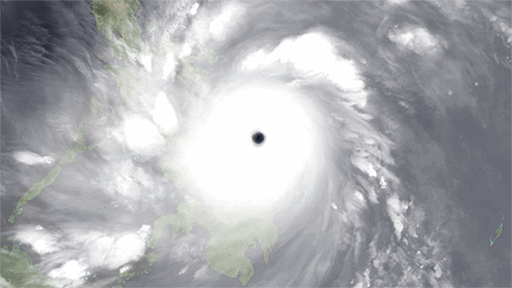
 Super Typhoon Haiyan Makes Its Presence Felt
Super Typhoon Haiyan Makes Its Presence Felt
08Nov13
A storm to remember. Super typoon Haiyan was displaying sustained winds of 195 mph, with gusts of up to 235 mph, prior to landfall in the Philippines yesterday. This puts this super typhoon amongst the largest, most powerful storms in history and certainly the most powerful storm seen this year. A news article in Bloomberg summed it all up: "“If it maintains its strength, there has never been a storm this strong making landfall anywhere in the world,” said Jeff Masters, founder of Weather Underground in Ann Arbor, Michigan. “This is off the charts.” "
In the photo (right; from NOAA), some of the islands at the mouth of the Leyte Gulf in the Philippines can be seen through the incredibly well-defined eye of super typhoon Haiyan.

Photo Credit: NOAA
 HD (1080p) Video of the Mars Curiousity Descent Available
HD (1080p) Video of the Mars Curiousity Descent Available
21Aug12
A full-resolution version of the NASA Curiosity rover descent to Mars, taken by the MARDI descent imager can now be seen over on YouTube.
 Congratulations to the Mars Curiosity Rover Team!
Congratulations to the Mars Curiosity Rover Team!
07Aug12
They did it! The car-sized Curiosity rover safely made it to the surface of Mars after traveling some 350 million miles and performing an intricate techno-ballet in order to land, the latter on autopilot. Check out the latest in media, findings, and mission history at NASA's mission website.
While the whole thing is very cool, I found one aspect "over the top". Specifically, satellites previously sent to orbit Mars were able to capture pictures of the Mars Science Laboratory [MSL] during the landing phase of the mission! Check out the HiRISE [High Resolution Imaging Science Experiment] link for the latest images taken during MSL descent. I especially like the image showing the both the lander, parachute deployed, and the recently detached heat shield, itself free-falling to the Martian surface. Wow!
1
 The Variation in Ourselves
The Variation in Ourselves
17Nov12
Our genes, together with our environment, define who we are: what traits we have and how we are different from, yet so similar to, others. And in this era of the personalized genome analysis, for many of us, we speak or think about our own genome as a fixed entity, constant (for the most part) across all the cells and tissues of which we are composed. We believe that one genetic blueprint is at work in our body; In other words, we are reductionists. But reality may be much more complicated.
A new study by Yale University School of Medicine researchers and published in Nature indicates that genetic variations are widespread in the body’s tissues. The study was prompted by the growing number of reports indicating a possible methodological limitation in creating one type of new stem cells: that reprogramming somatic cells into induced pluripotent stem cells (iPSCs) may cause de novo gene copy number variation. The ability to create iPSCs has enormous implications for regenerative medicine but the possibility that reprogramming somatic cells into stem cells causes genomic instability could be a serious impediment. A number of human diseases, including cancer, are associated with somatic mosaicism [example] and it has even been suggested that mosaicism “…implies that some tissues literally evolve throughout life”. The present study suggests that somatic mosaicism may be a characteristic of normal, healthy tissues, in this case the skin.
In ascertaining whether reprogramming does indeed contribute to copy number variation, the authors showed that at least 50% of detected copy number variants in iPSCs derived from skin [fibroblast] cells are present as low-frequency somatic genomic variants in the parental fibroblasts and are manifested in iPSC lines owing to their clonal origin. In other words, structural alterations to a cell’s DNA occur post-zygotically and to a significant extent.
The implications of this study are not just a matter of the concepts we operate under. For example, how we perform and analyze genetic screening could be profoundly impacted by these results, particularly if the source cells are those that turnover rapidly in the body. In addition, somatic mosaicism may help explain why some genetic traits exhibit complex inheritance. And if evidence of a functional heterogeneity, at the organ or tissue level, was ever tied to such somatic mosaicism, as may be the case in some localized diseases, then a profound shift in our understanding of disease could well be in order.
© 2012-2014 Acton Biotech Consulting - See Image Credits page for attribution and license conditions for non-original images/media.
Important DISCLAIMER - This is a science & technology website and not a medical treatment or diagnostic site. No information contained within this site is a substitute for advice or direction given by qualified medical professionals, nor is it intended to inform patients regarding treatment options or disease diagnosis/prognosis. As always, individuals should consult their own medical team about issues concerning their health and well being.

